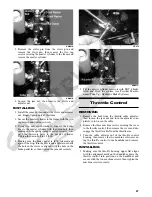
26
KM800A
3. Remove the brake lever, brakelight switch, and brake
lever lock.
INSPECTING
1. Inspect the pivot bolt securing the brake lever for
wear.
2. Inspect the brake lever for elongation of the pivot
hole.
3. Inspect the reservoir for cracks and leakage.
4. Inspect the brake hose for cracks and deterioration
and the condition of the fittings (threaded and com-
pression).
5. Inspect the brakelight switch for corrosion, cracks,
missing or broken mounting tabs, or broken and
frayed wiring.
NOTE: If the brakelight switch is determined to be
not serviceable, see Electrical System - Taillight -
Brakelight.
INSTALLING
1. Install the brakelight switch on the master cylinder;
then install the brake lever and brake lever lock.
2. Install the master cylinder assembly on the handlebar
engaging the alignment stud in the hole in the han-
dlebar; then secure with the master cylinder clamp
and two cap screws. Make sure the UP arrow on the
clamp is directed upward.
KM800B
3. Tighten the cap screw (1) to 13 ft-lb; then tighten the
cap screw (2) to 13 ft-lb.
KM800B
4. Using new crush washers, secure the brake hose to
the master cylinder with the brake hose union bolt.
Tighten to 25 ft-lb.
KM800A
5. Fill the master cylinder with DOT 4 brake fluid; then
bleed the system (see Periodic Maintenance -
Hydraulic Brake Systems).
Auxiliary Brake Pedal/
Master Cylinder
Assembly
NOTE: The auxiliary brake master cylinder is a non-
serviceable component; it must be replaced as an
assembly.
REMOVING
1. Connect a clear plastic hose to the appropriate bleed
screw on the rear brake caliper; then loosen the bleed
screw and pump the foot brake until the fluid is
pumped into a suitable container.
2. Compress the reservoir clamp and remove the reser-
voir hose; then remove the union bolt. Account for
and discard two crush washers.
CAUTION
Brake fluid is highly corrosive. Do not spill brake fluid
on any surface of the ATV.
















































